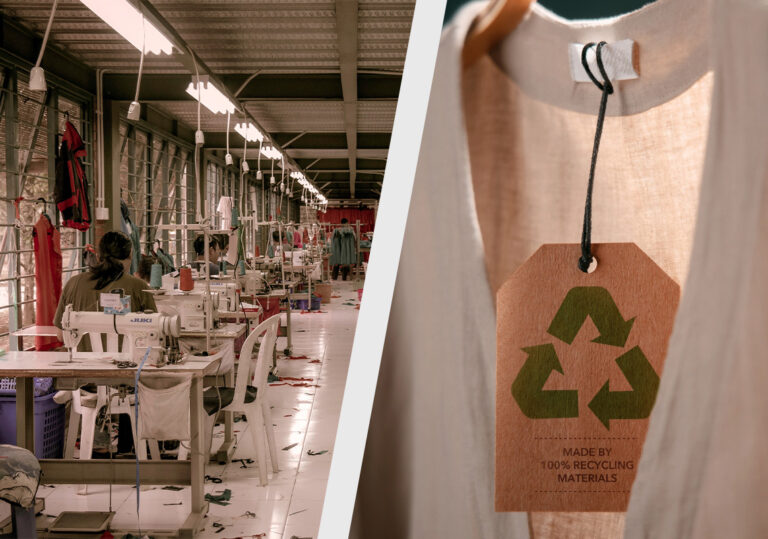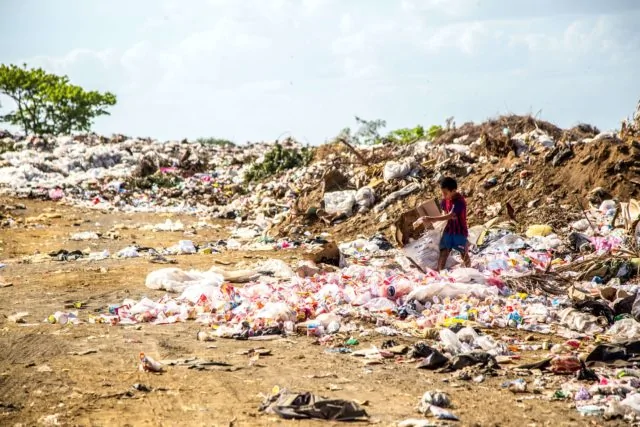Fast fashion appears to be an inescapable part of modern life. In these image-driven times, people are bombarded with the latest fashion trends and celebrity photos that have been carefully positioned to encourage them to spend. Mass-produced fashion is cheap and fast-moving, making it easy for consumers to keep up with the latest styles.
The burgeoning fast fashion industry comes with a cost. People are wearing their clothes less and discarding them more quickly. The quality and durability of clothing are also down. This keeps the consumer trapped in a cycle of buying which satisfies clothing manufacturers but does massive environmental harm.
The sustainable fashion industry appears to be an alternative to the destructive cycle that is being perpetuated by fast fashion, but how do they compare? In this article, we deep dive into 14 differences between fast fashion vs sustainable fashion that will show you the extent of the crisis in fashion and the possible solutions.
What is fast fashion?
Fast fashion is clothing designed and manufactured to quickly and cheaply copy the latest trends. This type of mass-manufactured clothing is based on runway styles or celebrity outfits. It moves quickly from design through manufacture to stores to take maximum advantage of consumer interest and demand.
People can now purchase the latest looks or get a ‘fashion fix’ affordably. Speedy manufacturing processes and global shipping methods mean companies can continually turn out new collections. This fashion sector moves so quickly that new designs can be on sale multiple times per week.

Fast fashion has changed the way people shop for clothes
Over the last 30 years, how people shop for clothes has completely changed. Before the fast fashion revolution in the late 1990s, people would buy their clothes seasonally and wear them for longer. Clothing was more expensive, and shopping was a big event.
Fashion shows were originally a preview of upcoming clothing collections that would be retailed for months at a time. Fast fashion has changed consumer appetites increasing demand for new styles continuously and the instant gratification of being on trend. The rise of e-commerce has further accelerated these changes.
With fast fashion, quality is low on the list
Fast fashion has been developed to respond quickly to consumer demand with cost-efficient clothing. The priority is to provide fashionable clothing at a low cost, with little care for the quality or durability of the garments.
What is sustainable fashion?
Sustainable, ethical, or eco-fashion is a broad term that encompasses clothing production and distribution methods developed to reduce the environmental impact of clothing production, improve garment worker welfare and introduce social justice to the fashion industry.
A key aim of sustainable fashion is to completely reform the lifecycle of clothing, from the materials used to manufacture clothes to what happens to clothing at the end of its usable life. This proactive approach to reducing the environmental impact of sustainable fashion has a noted positive impact on the pollution and waste that is notorious in the fashion industry.

Sustainability in fashion has been an issue since the 1960s environmentalism movements, which questioned the necessity of mass-manufacturing clothing and identified its polluting effects. Awareness and adoption of sustainable practices in fashion have been patchy due to the increased costs involved.
Sustainable fashion has championed key innovations in textile recycling and reprocessing that are gradually being adopted by fast fashion manufacturers that want to improve their ‘green’ credentials. The exemplary practices of the sustainable fashion movement have not fully penetrated the fast fashion industry, which may need to be reformed using tariffs or standards.
14 differences between fast fashion vs sustainable fashion
Understanding the differences between the fast and sustainable fashion industries drives home the scale of the environmental impact of clothing. These two sectors within the fashion industry have massive differences that everyone should know about to make more informed choices about the clothes they wear.
1. Clothing industry size and scale
The global fast fashion market is worth more than $91 billion. Since 2016, it has experienced runaway growth sustaining a compound annual growth rate (CAGR) of over 1.69%. By 2026 industry experts expect that the size of the fast fashion market may have almost doubled to more than $173 billion as adoption increases internationally.
In contrast, sustainable clothing has a much smaller market share. Analysts estimate the size of the ethical fashion market to be over $7.5 billion (2022). This market is also accelerating, with a compound annual growth rate (CAGR) of over 6.5% since 2017. By 2027 the size of the sustainable fashion market is expected to still be modest relative to fast fashion at $11 billion+.
2. Clothing industry market drivers
Fast fashion has numerous drivers that have kept its market share large. These include:
- The growth of fast fashion and organized retail networks in emerging markets
- High penetration of social media and digital marketing into populations
- A rise in demand for sports and performance wear
- The rise of e-commerce
- Reductions in manufacturing costs due to globalization
- Urbanization
- A burgeoning young population in developing countries and emerging markets
Growth drivers for sustainable fashion have centered on social awareness and include:
- Increasing awareness of poor working conditions endured by workers to deliver fast fashion
- Awareness of the negative environmental impact of fast fashion
- Consumer demand for sustainable or ethical fashion
- Reductions in free trade and access to global markets
- Raw material shortages
3. Raw materials used
Fast fashion is a massive consumer of natural resources. Every year, 70 million barrels of oil go into producing synthetic fibers and fabrics for shiny, stretchy, and clingy fast fashion.
And it’s not only synthetics that are a problem. Fast fashion also places strain on global cotton availability.
The high turnover of these cheap clothes also consumes vast amounts of water and energy, in their continuous production, making this a very resource-expensive type of clothing over the long term.

In contrast, sustainable fashion reuses and repurposes existing textiles or uses demonstrably sustainable materials like hemp or bamboo linen. The sustainable fashion industry avoids the use of raw materials for fabric as much as possible. Investment goes into the advanced reprocessing of waste textiles, meaning using fewer raw materials.
4. Manufacturing methods
Fast fashion has been made possible by introducing automation and mass manufacturing of fabrics and garments. Fabrics are spun from oil-based synthetic fibers and woven into cheap fabrics.
By the time they are sewn into garments, these poor-quality fabrics have been bleached or dyed, treated with retardants and other chemicals, and printed. The prioritization of speed and low cost means that the assembly quality is poor, meaning that many items may even be discarded before they leave the manufacturing plant.
Sustainable clothing manufacturers take large volumes of discarded textiles that are shredded, respun, and woven into new fabrics. These recycled fabrics underpin sustainable clothing manufacture. Dyes, printing, and embellishments use eco-friendly materials.
5. Garment factory conditions
Fast fashion requires a supply chain developed for speed so that clothing manufacturers can rapidly respond to new trends. To achieve high volume, rapidly produced clothing cheaply, fashion firms may neglect ethical standards and use factories that have poor working conditions. Issues affecting workers in the garment industry include the sexual exploitation of women, child labor, and sweatshops.
Take a look inside the fast fashion industry:
The holistic approach of sustainable fashion is less intensive with greater concern for the welfare of workers. This usually makes clothing production more expensive and slower. Sustainable fashion consumers are concerned that garment trade workers are paid fair wages and have decent working conditions.
6. Chemical use
The textile industry uses a variety of hazardous chemicals and toxins that damage human health and the environment. These chemicals are used at every stage of processing and finishing fabrics and garments and include, bleaching agents, dyes, surfactants, and inks.
Examples of toxic chemicals routinely used in fast fashion include:
- Formaldehyde
- Quaternary ammonium compounds
- Oxy-ethylated polyamides
- Silica gel
- Disperse dyes
- Azo dyes
- Chlorinated flame retardants
Though these chemicals improve the look and feel of garments, they generate hazardous wastewater that can pollute drinking water and harm aquatic life. Many of these chemicals are allergens and aggravate conditions like asthma and eczema.
Some of these chemicals are also used in sustainable fashion production as garments are expected to meet legal standards of flame retardancy and achieve a wearable finish.
However, sustainable garments tend to use fabric processing compounds that are free from the most toxic chemicals and limit the impact of textile production on waterways and the wider environment. Quality standards such as Oeko-Tex® are used to assure consumers that harmful chemicals are not present in the garments.
7. Garment quality
One of the biggest differences between fast fashion and sustainable fashion is the quality and durability of the garments produced. They are not intended to last long as the fast fashion industry wants customers to buy new clothes repeatedly.
Fast fashion is designed to be low-cost and high turnover to satisfy the demands of fleeting trends. This means that companies cut costs on the quality of fabrics and their assembly leading to cheap clothes that do not wash or wear well and are soon discarded.

Sustainable fashion takes a different, less consumer-centric approach. Garment design and manufacture are far more considered, with a focus on increasing the longevity of clothes so that fewer raw materials are required long term. Sustainable fashion manufacturers and retailers may invest in novel recycled textiles, repurposed and recycled clothing, and better garment assembly to deliver a better quality, albeit more expensive, product.
8. Cost of clothing
The factors that determine the price a customer pays for an item of clothing include:
- Fabric costs
- The price of notions and embellishments like buttons and zippers
- Labor costs for making the garment
- Transport, logistics, and warehousing costs for completed garment orders
- Marketing and merchandising costs
- Manufacturer, supplier, and retailer profit
Fast fashion is designed to be cheap and accessible to the widest possible range of customers. At every stage of a fast, mass-produced fashion’s design, production, marketing, and retail, costs are kept as low as possible so that sales volumes can be maximized.
The fast fashion industry cannot entertain concepts like recycling or reprocessing textiles as they add cost to the business model. As long as it is cheaper to work with raw materials, this fast fashion will continue to consume them.
Sustainable clothing is currently more expensive than fast fashion, especially as its sales volumes are lower. Sustainable fashion costs more to produce, especially when a fair wage and ethical employment practices are implemented in factories. Reprocessing waste fabrics to make new materials is also expensive and energy intensive.
These costs are passed on to the customer who often makes a deliberate decision to buy sustainable clothing. However, the quality and durability of sustainable garments mean that consumers can avoid buying new garments repeatedly.
9. Waste
Just take a look at what is happening in Kenya and other parts of the world right now because of fast fashion:
Fast fashion generates huge waste. Consumers are saturated with an immense amount of choice, meaning that vast quantities of wearable clothing often go straight to waste. If garments go unused and unsold, they often end up in landfills or shipped abroad, where the poor quality of the garments means that they are quickly discarded.
According to Earth.org, 92 million tonnes of fabric waste is produced each year, with over $500 billion wasted due to underworn and discarded clothes. Every American discards at least 81.5 pounds (37 kilograms) of clothing annually. Waste textiles are a massive pollutant, choking waterways and releasing microplastics into seas.
The sustainable fashion movement has emerged, in part, due to the shocking levels of fast fashion waste. Innovative manufacturers actively recycle waste textiles to make better quality clothing that does not need to be discarded.
As consumers become more aware of the impact that their appetite for disposable clothing is having on the environment, many are optioning to purchase sustainable items.
10. Clothing product miles
The fashion industry is responsible for at least 10% of global CO2 emissions, with each garment often clocking up many ‘product miles’ before it gets to the consumer. The supply chain for fashion is global with fabric and clothing routinely traveling by shipping or air freight, which are both highly polluting.
Some sustainable clothing is also transported using these methods, but designers and manufacturers within this sector have also explored minimizing the product miles of the clothing they produce by making garments locally.
In Western countries, this can add significantly to the cost of producing clothing especially compared to factories in Asia and Latin America, where fast fashion is mass-produced.
11. Recycling clothing
Despite being entirely possible, clothing recycling is not a part of the fast fashion business model. Fast fashion retailers’ singular concern is selling as many products as possible, with little care for where it ends up long-term.
The marketing of this type of clothing is focused on its appearance and how you’ll feel wearing it with little mention of its quality or sustainability. Though marketing channels could be used to promote clothing recycling, it is not part of the lifespan of a fast fashion garment.
Sustainable fashion has championed and advanced textile reprocessing and recycling since its inception. This jeans factory in Pakistan is a great example:
Textile recycling methods that this sector has championed have begun to be adopted by mainstream clothing brands. For example, H&M, a fast fashion retailer, has invested in its textile recycling machines to create sustainable clothing for sale in its stores:
12. Repairs and alterations
Fast fashion is cheaply made and not designed for repairs or alteration. A fast fashion garment’s materials and fabrication quality are already low when purchased, meaning that the garment fails quickly after sustained washing and wear. Throwing damaged clothing, shoes, and accessories in the bin is often cheaper than paying for a professional repair.
Sustainable fashion seeks to be part of a circular economy, where the longevity of garments can be maximized by incentivizing repair. Clothing companies and retailers transitioning to becoming more sustainable have introduced alteration and repair services for the garments they sell to encourage people to wear their clothes for longer. Levis is a great example:
13. Brands and retailers
Fast fashion is big business, and international brands are profiting from churning out massive volumes of cheap clothing, which is then shipped worldwide. Many customers need to be made aware of the provenance and environmental impact of their clothing, which limits their inclination and opportunity to make a sustainable choice.
Examples of fast fashion international brands include:
- Shein
- BooHoo
- Uniqlo
- Primark
- Victoria’s Secret
- GAP
- Zara
- Fashion Nova
- H&M
Sustainable fashion brands are more niche. Their smaller market share means that customers consciously decide to purchase them, often because they seek a more sustainable lifestyle.
Examples of sustainable fashion brands with global reach include:
- Stella McCartney
- Patagonia
- Craghoppers
- Levis
- PACT
- Everlane
- thredUP
For more examples of sustainable fashion brands, check out our round-up reviews of the best sustainable swimwear, sustainable pajamas, and sustainable slippers.
14. Sustainability
Fast fashion simply is not sustainable long-term. It is a massive polluter of the environment, consumers, and natural resources and a sustainer of unethical labor practices worldwide. In many parts of the world, especially countries that are heavily polluted by textile waste, people are seeking for fast fashion companies to take responsibility for the massive amounts of waste and pollution they are generating.
The sustainable fashion industry could be better, but using recycled textiles, opting for eco-friendly dyes, and producing better quality garments is rapidly progressing towards a sustainable, circular economy.
Rounding up
People care about the environmental impact of fashion, but it isn’t always the first thing that comes to mind when you want to look good. For far too long, the fast fashion industry has gotten away with producing cheap disposable clothing without bearing the costs of the environmental problems they are generating.
Sustainable fashion is gradually becoming more widely adopted, but fast fashion companies need to be disincentivized from squandering natural resources on what is essential clothing waste. Some fast fashion companies, like H&M, are beginning to step up to their responsibilities and demonstrate that fast fashion can treat the Earth (and their customers) much better.











